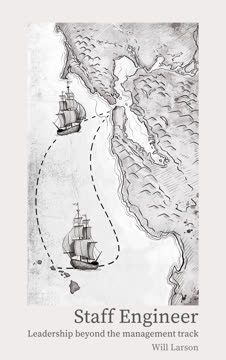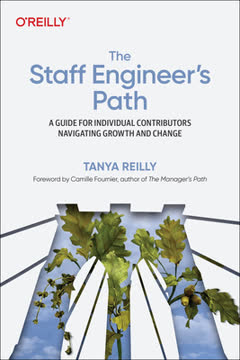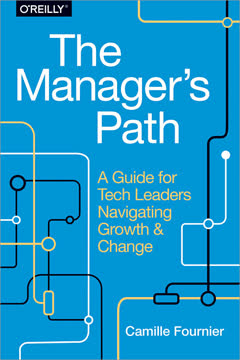Key Takeaways
1. Management is a distinct career path requiring new skills
Management is not the natural progression of the skills you develop as a senior engineer, it's really a whole new set of skills and challenges.
Transitioning to management requires a mindset shift from individual contributor to team enabler. Key skills to develop include:
- Communication: Clearly conveying expectations, feedback, and vision
- Delegation: Assigning tasks and empowering team members
- Strategic thinking: Understanding business goals and aligning team efforts
- Emotional intelligence: Managing interpersonal dynamics and conflicts
Challenges in the transition often include:
- Letting go of hands-on technical work
- Learning to measure success through team achievements
- Balancing individual relationships with overall team needs
- Developing a leadership style that fits both personal strengths and team culture
2. Mentoring and tech leadership are stepping stones to management
Mentoring is training you to pay attention to the individuals on your team, which in turn makes it easier to recognize and foster talent.
Mentoring helps develop crucial management skills:
- Active listening and empathy
- Providing constructive feedback
- Identifying and nurturing potential
Tech leadership bridges technical expertise and people management:
- Guiding technical decisions while considering business impact
- Managing project timelines and resources
- Facilitating communication between technical and non-technical stakeholders
Both roles provide opportunities to practice influence without formal authority, a key skill for future managers. They also help potential managers gauge their interest and aptitude for leadership roles before fully committing to a management track.
3. People management involves clear communication and continuous feedback
Continuous feedback works best when you, as a manager, pair that feedback with coaching.
Effective communication is the foundation of people management:
- Regular 1-on-1 meetings to discuss progress, challenges, and goals
- Clear articulation of expectations and performance standards
- Open channels for team members to voice concerns and ideas
Continuous feedback should be:
- Timely: Addressing issues or achievements promptly
- Specific: Focusing on concrete behaviors or outcomes
- Balanced: Recognizing both strengths and areas for improvement
- Action-oriented: Providing clear steps for growth or change
Managers should strive to create a culture of trust where feedback flows in both directions. This involves being open to receiving feedback from team members and demonstrating how to act on constructive criticism.
4. Managing teams requires balancing technical involvement and leadership
Your productivity is now less important than the productivity of the whole team.
Shifting focus from individual contribution to team enablement:
- Prioritize removing obstacles for the team over personal technical tasks
- Develop systems and processes that improve overall team efficiency
- Foster a culture of collaboration and knowledge sharing
Maintaining technical credibility while stepping back from day-to-day coding:
- Stay involved in high-level technical decisions and architecture discussions
- Participate in code reviews for critical components
- Keep up with industry trends and new technologies
Successful team managers find ways to leverage their technical expertise to guide the team's direction and strategy, while empowering individual contributors to take ownership of implementation details. This balance helps maintain respect from technical team members while focusing on broader leadership responsibilities.
5. Overseeing multiple teams demands strategic thinking and delegation
Delegation is the primary way you claw yourself out of the feeling of having too many plates spinning at once.
Strategic thinking becomes crucial when managing multiple teams:
- Aligning team goals with overall organizational objectives
- Identifying synergies and potential conflicts between teams
- Prioritizing resources and efforts across different projects
Effective delegation is key to scaling leadership:
- Empowering team leads to make decisions
- Clearly defining responsibilities and authority levels
- Providing support and guidance without micromanaging
Managers at this level must develop a higher-level view of the organization while maintaining enough connection to spot issues early. This often involves:
- Establishing clear communication channels and reporting structures
- Implementing consistent processes across teams for better coordination
- Regularly assessing and adjusting team structures and responsibilities
6. Senior leadership focuses on shaping organizational culture and strategy
Culture is how things get done, without people having to think about it.
Shaping organizational culture involves:
- Articulating and embodying core values
- Creating systems that reinforce desired behaviors
- Addressing cultural misalignments promptly
Strategic leadership requires:
- Long-term vision setting
- Balancing business needs with technical considerations
- Making high-stakes decisions with incomplete information
Senior leaders must navigate complex stakeholder relationships, including:
- Board members and investors
- Executive peers from other departments
- External partners and customers
Their actions and decisions have far-reaching impacts, necessitating a broad understanding of the business, industry trends, and potential future scenarios. Effective senior leaders consistently communicate the organization's vision and strategy, aligning efforts across all levels of the company.
7. Effective processes and structures evolve with company growth
A complex system that works is invariably found to have evolved from a simple system that worked.
Adapting processes as the company grows:
- Start with lightweight processes that solve immediate problems
- Regularly reassess and adjust as the team expands
- Balance structure with flexibility to maintain agility
Key areas to evolve:
- Hiring and onboarding processes
- Performance evaluation and career development frameworks
- Project management and decision-making structures
- Communication channels and information sharing practices
Effective leaders recognize that processes should serve the team, not vice versa. They involve team members in process development to ensure buy-in and relevance. As the company grows, cross-functional collaboration becomes increasingly important, often leading to matrix-style organizational structures that balance functional expertise with product-focused teams.
Last updated:
FAQ
What's The Manager's Path about?
- Focus on Engineering Management: The Manager's Path by Camille Fournier is a guide for engineering managers, covering career stages from being managed to leading organizations.
- Career Development: It emphasizes understanding the unique challenges of engineering management and offers tactical advice for career growth.
- Real-World Insights: Fournier shares personal experiences and lessons, making the content relatable and applicable to tech leaders.
Why should I read The Manager's Path?
- Practical Guidance: Offers actionable advice for improving management skills, addressing common pitfalls, and providing strategies to overcome them.
- Industry-Relevant: Valuable for tech leaders, especially in software engineering, where management practices differ from other industries.
- Structured Learning: Organized to follow an engineer's career path, making it easy to reference specific challenges and solutions.
What are the key takeaways of The Manager's Path?
- Understanding Management Roles: Management is a new skill set, not just a promotion, requiring continuous learning and adaptation.
- Importance of Communication: Effective communication, including regular one-on-one meetings, is crucial for fostering a healthy team environment.
- Navigating Challenges: Provides strategies for managing conflict, providing feedback, and ensuring team cohesion, emphasizing a supportive team culture.
What are the best quotes from The Manager's Path and what do they mean?
- "The secret of managing...": Highlights the complexities of management and the importance of maintaining team dynamics.
- "You’re reading this book...": Challenges readers to reflect on their understanding of effective management and seek clarity on what it entails.
- "Being a good leader...": Emphasizes that successful management relies more on interpersonal skills than technical expertise.
How does The Manager's Path define effective management?
- People-Centric Approach: Effective management involves supporting and developing team members while achieving organizational goals.
- Clear Communication: Regular communication, including one-on-one meetings, builds trust and transparency within the team.
- Adaptability and Growth: Good managers are adaptable, open to feedback, and willing to adjust their management style to meet team needs.
What strategies does The Manager's Path suggest for managing conflict?
- Address Issues Early: Emphasizes addressing conflicts promptly to maintain team cohesion and morale.
- Encourage Open Communication: Creating a safe environment for team members to express concerns is crucial.
- Use Structured Processes: Implementing clear processes for decision-making and conflict resolution fosters collaboration and reduces tension.
How can I improve my one-on-one meetings based on The Manager's Path?
- Regular Scheduling: Schedule weekly one-on-one meetings to maintain consistent communication and build rapport.
- Prepare Agendas: Both managers and team members should come prepared with topics to ensure productive and focused meetings.
- Foster Open Dialogue: Create a safe space for team members to share thoughts and concerns, reinforcing a culture of trust and support.
What are some common pitfalls for new managers discussed in The Manager's Path?
- Micromanagement: Tendency to micromanage can undermine team morale; trust and delegate responsibilities effectively.
- Avoiding Conflict: Struggling with addressing conflicts can lead to unresolved issues; confront conflicts directly and foster open communication.
- Neglecting Team Dynamics: Focusing solely on individual performance can lead to dysfunction; build a supportive team environment.
How does The Manager's Path address the challenges of managing outside your expertise?
- Be Curious and Learn: Approach unfamiliar areas with curiosity and a willingness to learn by asking questions and seeking guidance.
- Delegate Effectively: Delegate responsibilities to team members with the necessary expertise, empowering the team and focusing on strategic oversight.
- Build a Support Network: Establish a network of peers and mentors for insights and support when managing outside one’s expertise.
What role does culture play in The Manager's Path?
- Foundation of Success: Culture is the foundation for successful teams, fostering collaboration, innovation, and satisfaction.
- Guiding Principles: Define and communicate core values to guide team behavior and decision-making, creating a cohesive team.
- Evolving Culture: Culture evolves as the organization grows; leaders must actively shape and nurture it to align with company goals.
How can I apply the concepts from The Manager's Path to my team?
- Implement Regular One-on-Ones: Establish regular meetings to build trust and facilitate open communication about goals and feedback.
- Foster a Learning Culture: Encourage continuous learning through mentorship, training, and collaborative projects.
- Set Clear Expectations: Clearly communicate team goals and individual responsibilities to ensure alignment and contribute to team success.
What is the significance of skip-level meetings in The Manager's Path?
- Gain Insight: Skip-level meetings provide insights into team dynamics and potential issues before they escalate.
- Build Relationships: Foster relationships between senior leaders and team members, creating a sense of connection and engagement.
- Encourage Transparency: Promote transparency by allowing leaders to hear feedback and concerns directly from employees, improving morale and trust.
Review Summary
The Manager's Path receives mostly positive reviews, with readers praising its practical advice for software engineering careers. Many found it valuable for understanding different management levels and responsibilities. The book is commended for its clear writing and real-world examples. Some readers appreciated its insights even if not pursuing management roles. Criticisms include repetition, lack of depth on certain topics, and occasional US-centric focus. Overall, it's recommended for both aspiring managers and individual contributors in the tech industry.
Similar Books










Download PDF
Download EPUB
.epub digital book format is ideal for reading ebooks on phones, tablets, and e-readers.




